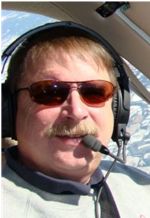
by jeff edwards
Overall the EA-B accident stats as reported by EAA this fiscal year look great, but I suspect the industry is over reporting its flying activity. Many of you are flying much less than 100 hours per year. If that's you, you shouldn't be surprise if your once Chuck Yeager-like pilot skills have atrophied. So get out and practice. Practice makes perfect!
What About Lancairs?
LOBO members have enjoyed a significant reduction in the accident rate this year. There has only been one fatal accident in the U.S. involving a Lancair in 2013. That accident involved a non-member flown 235 in McMinnville, Oregon on October 28, 2013. According to the NTSB:
“On October 28, 2013, about 1300 Pacific daylight time, a Musick Lancair O-235, N25DM, was conducting a low-level aerobatic maneuver and collided into a house in a residential neighborhood in McMinnville, Oregon. The pilot was the registered owner, and was operating the airplane under the provisions of 14 Code of Federal Regulations (CFR) Part 91. The private pilot, the sole occupant, sustained fatal injuries; the airplane was substantially damaged. The local personal flight departed from McMinnville Municipal Airport, McMinnville, about 1215. Visual meteorological conditions prevailed, and no flight plan had been filed.” (click here to read NTSB Factual Report WPR14FA037.)
Outside the U.S. there were two fatal Lancair accidents. One involving a suspected open canopy in Australia on October 25, 2013 resulted in two deaths. According to the ATSB:
“At about 1415 Eastern Daylight Time (EDT1) on 25 October 2013, an amateur-built Lancair Legacy aircraft, registered VH-ICZ, with the pilot and one passenger on-board, took off from Shepparton Airport, Victoria (Vic), for a flight to Yarrawonga, Vic. Witnesses reported that the take-off and initial climb appeared normal; however, shortly after, the aircraft’s pitch angle increased, followed by a descending right turn that continued until the aircraft collided with terrain alongside the airport boundary. The pilot and passenger were fatally injured.” (click here to read Australian Transport Safety Board Report AO-2013-193)
The second occurred on September 17, 2013 in Shenyang, China. David Riggs and a passenger were killed when the Canadian-registered 360 crashed for as yet to be determined reasons. Riggs was in China to perform during a scheduled airshow. 2013 saw four non-fatal Lancair accidents in the U.S. Two involved gear collapses and/or gear up landings; one 360 experienced an electrical fire and resulted in serious injuries to the pilot and passenger; and the fourth was a runway excursion accident. With respect to the 360 inflight fire the NTSB stated:
The battery was located in the upper footwell of the right seat, and had sustained extensive thermal damage, with only remnants of its inner plates remaining. All the electrical wiring for the alternator, battery, and engine starting systems had been charred, with most of their insulating material burned away. The wires were examined, and the 4-AWG copper conductor, which directly connected the master solenoid output to the main system bus, had sustained breakage to 11 of its 19 strands, 33 inches from the master solenoid terminal. The area of the damage was located in a position roughly adjacent to the center console in the foot well area. Closer examination of the damaged area revealed that the wire separation surfaces exhibited gray glass-like coatings, and globular melting patterns consistent with fusion and electrical arcing damage. The input side of the master solenoid remained attached directly to the battery’s positive terminal.
All remaining electrical wires were examined, and exhibited sooting and brittle fractures, consistent with thermal exposure and subsequent movement during the airplane's recovery from the accident site.
Original Lancair construction documentation called for the battery to be installed on the rear side of the aft cabin bulkhead, just behind the right seat. The documentation further stated that moving the battery location is permissible in order to achieve the correct airplane weight and balance. Examination of maintenance logbooks revealed that the battery was relocated on three occasions between April 1993 and September 1998. The final placement of the battery would have required rerouting and/or replacement of the master bus electrical wire.
Examination of the unburned airplane remnants revealed extensive use of automotive electrical wires and PVC tubing to route wiring through the wing structure. (click here to read NTSB Factual Report WPR13LA122.)
This is the second reported fire in a wee Lancair in two years. Many of these aircraft are approaching 20 years plus in age with similarly aged wiring. Some were built with non-aviation grade wiring and not necessarily in accordance with acceptable methods, procedures and practices. Chafing and aged wiring does not make a good companion in an aircraft. All Lancair owners should pay close attention to the wire bundles at condition inspection time. A recent email from Chris Zavatson reported extensive firewall damage caused by improperly installed electrical lines--something that should have been noticed years ago. Be safe!
